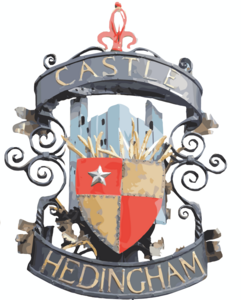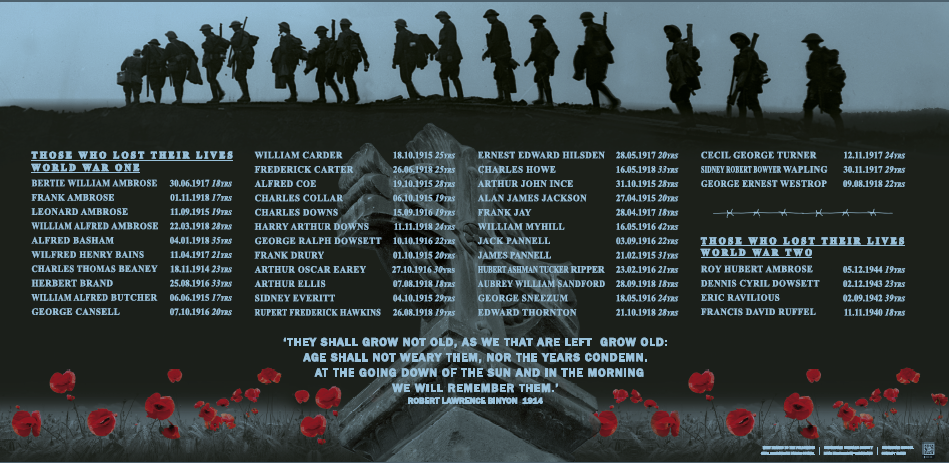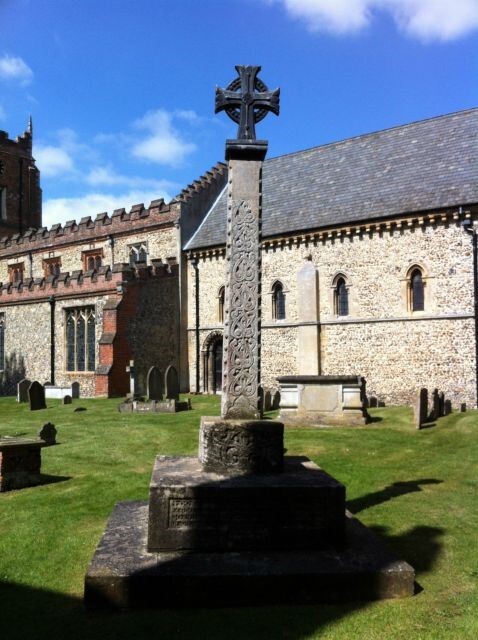CASTLE HEDINGHAM WAR MEMORIAL 2018
November 11th 2018 was of particular significance, commemorating 100 years since the ending of World War I.
In Castle Hedingham, the population of men was decimated during the four years of bloody and terrible conflict. 37 young men, 10% of the parish’s male population, many still in their teens, were killed. Every family in the village was affected and felt the loss. Ros Johnson has researched each young man who gave his life, and her full document is available here:
Castle Hedingham War Dead 1914-1918
In recognition of this conflict and also the fewer World War II losses coming so soon after, Castle Hedingham Parish Council in co-operation with Hedingham Heritage Society and the British Legion planted an avenue of trees along Sheepcot Road. Each tree remembers the loss of one life in our parish, in the two twentieth century World Wars.
On the morning of 11th November 2018 at 10am at Castle Hedingham Cemetery a memorial board at the Sheepcot Road Cemetery was unveiled to commemorate and detail these losses.
CASTLE HEDINGHAM WAR MEMORIAL, ST NICHOLAS CHURCH
In 2014, Castle Hedingham Parish Council was awarded £12,855 for the refurbishment of the St Nicholas War Memorial from the Grants for War Memorials scheme which was jointly funded by English Heritage and The Wolfson Foundation for the repair and conservation of freestanding war memorials in England. This scheme was administered by War Memorials Trust. War Memorial conservation report 2015
The cross is an example of Anglo-Norman workmanship of the early 12th century and was originally made to stand as a wayside cross at Crouch Green (cruc in Latin) in Castle Hedingham, and was accompanied by a chapel used by the Benedictine nuns at the nearby priory erected in the 12th century. The older part of the monument is made of Barnack limestone from the quarries of that name owned by the abbey of Peterborough, and is the same material used for the ashlar cladding and interior stonework at both Hedingham Castle and St Nicholas Parish Church. The quarry is now exhausted and is a nature reserve.
The cross stood at Crouch Green for 400 years before being thrown down at the Dissolution of the Monasteries by King Henry VIII in around 1535. The carving is different on each of the four sides of the shaft, with the finest carving placed so as to face the highway. This side now faces the entrance to the churchyard from Falcon Square, and like the base is carved with a series of palmettes said to be based on the illuminated pages of the St Edmundsbury Bible of 1135 AD.
For many years the original shaft and base were used in the cellars of the Falcon Inn to support the cellar roof. Edward Bingham, the Victorian potter now renowned for his Castle Hedingham ware, recognised it as an important relic of the medieval period of Castle Hedingham. The owner, Mr Kendall, kindly gave the cross shaft and base to the village, only being reimbursed for the cost of a replacement support.
In 1921 a cross in lead was added to the shaft which was then placed on a plinth carved in gothic lettering with the names of the 37 men who gave their lives in World War I.
The Inscription reads:
To the glory of God, this twelfth century cross was recovered and restored to the churchyard, A.D.1921 in memory of those who fell in the Great War, 1914 – 1918.
To this list were added the names of those men who died in service in World War II.
A large crowd gathered to celebrate the dedication of the War Memorial at a service held on the 13th November 1921. Many parishioners had to stand outside during the church service which preceded the dedication which was attended by friends and relatives of the fallen, together with a large congregation of ex-servicemen, schoolchildren and choristers. The memorial was unveiled by Lt. Col. George Symonds of Moyns Park, Birdbrook, with music which was provided by a brass and string band conducted by R. Francis.
During the service, prayers of dedication were led by the Reverend George Twist, priest of this parish, and the names of the fallen were read by Mr Harry Tucker Ripper, with a half muffled peal being rung on the church bells to conclude the ceremony.
The ceremony was led by the incumbent, the Right Reverend Bishop E. N Powell, who was largely responsible for the return of the ancient cross to ecclesiastical use once again.
Note: The “cat stoup” inside the church is thought to have been the finial of the cross before the Reformation. It is not known what happened to the original crucifix which once topped the shaft. Part of the shaft itself is still in private hands and the missing portion is modelled in cement.
The cross is rightly regarded as being one of the finest of its type in the country and like both the Castle and the Parish Church was very likely to have been commissioned by the Norman family of de Vere, who held the honour of Hengham ad Castrum (as it was then known) from King William I. The de Veres as the Earls of Oxford held the manor until 1625 when the 18th Earl Henry de Vere died in Holland during the wars of the low countries.


